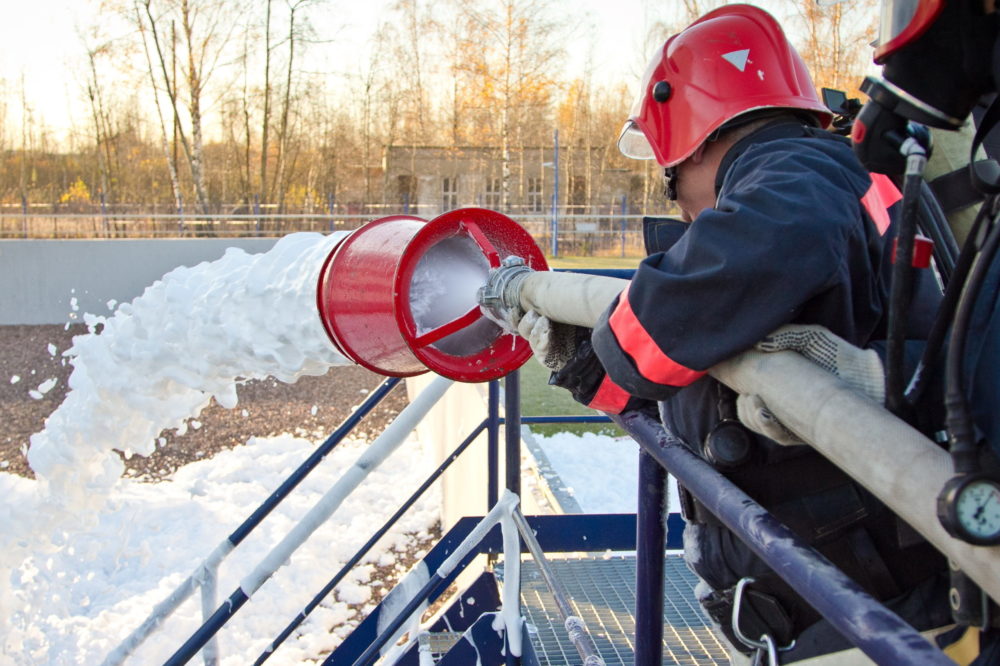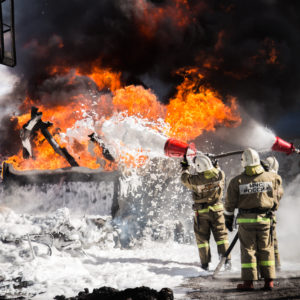New York Poised To Ban Burning of Toxic Film-Forming Foam Used By Firefighters

A bill passed the New York state legislature last week, which will partially ban the burning of a type of firefighting foam that contains toxic and cancer-causing chemicals, if signed by Governor Andrew Cuomo.
Aqueous film-forming foam (AFFF) has been used for decades at military bases and by some civilian fire fighting organizations throughout the United States to fight petroleum-based fires which cannot be controlled or subdued by water alone. However, concerns have emerged about the potential side effects of the firefighting foam that contains Perfluorooctanoic Acid (PFOA) and Perfluorooctanesulfonic acid (PFOS), which are cancer-causing chemicals that are collectively known as per- and poly-fluoroalkyl substances (PFAS).
Residents of the Capitol Region of New York have raised objections over plans to dispose of AFFF at the Norlite Hazardous Waste facility in Cohoes, which the Department of Defense gave permission to burn the firefighting foam. However, the move came without an environmental review, and local officials, residents, and environmental groups indicate that they may be exposed to potentially toxic fumes released by burning off the foam. In addition, a number of nearby waterways have been found to already be contamined with PFAS chemicals, which may increase the risk of cancer and other diseases.

Learn More About
Exposure to firefighting foam chemicals may result in an increased risk of cancer for firefighters, military and airport personnel.
Learn More About this Lawsuit SEE IF YOU QUALIFY FOR COMPENSATIONOn June 10, the New York State Legislature passed bill S7880B, which partially bans the burning of AFFF foam, specifically in communities with populations between 16,000 and 17,000 residents, which observers say was specifically meant to target the Cohoes facility.
The bill now goes to New York Governor Cuomo, who is expected to sign it.
Film-Forming Foam Health Risks
PFAS were first introduced into the manufacturing industry in the 1940’s, because of their ability to resist heat, grease, stains, and water. However, since the chemicals became widely used in firefighter foam since the mid-1960s, exposure has been linked to a myriad of adverse health effects including liver damage, thyroid disease, decreased fertility, high cholesterol, obesity, hormone suppression, and cancer.
In addition to firefighting foams, PFASs are chemical substances used to manufacture a number of products, including food packaging materials, pizza boxes, popcorn bags, fabrics, nonstick cooking pans, and other products. The firefighting foam has been regularly used at military bases nationwide over the past decade during routine fire extinguishing exercises, and is increasingly used by civilian firefighters.
The chemicals are projected to take thousands of years to degrade, and past studies have shown their ability to enter and stay in the environment and human body through the air, dust, food, soil, and water. Previous U.S. Centers for Disease Control and Prevention (CDC) studies have shown PFAS chemicals primarily settle into the blood, kidney and liver, and could likely be detected in the blood of 98% of the U.S. population.
In June 2019, a federal investigation found that PFAS chemicals are commonly found in numerous food products, including meats, seafood, chocolate, cake and other products. However, the FDA released a statement indicating that the levels found do not raise health concerns, based on the best available science.
According to findings published in the Journal of the American Medical Association in 2012, exposure may also suppress the immune system and limit the ability of the body to create antibodies in response to childhood vaccines.
The legislation comes as a growing number of former civilian and military firefighters are pursing film forming foam lawsuits, indicating that they developed testicular cancer, kidney cancer and other malignancies after years of exposure to the firefighting foam.
In December 2018, cases filed throughout the federal court system were centralized for pretrial proceedings in the U.S. District Court for the District of South Carolina, as part of an MDL or multidistrict litigation.
Get more articles like this sent directly to your inbox.
"*" indicates required fields






0 Comments